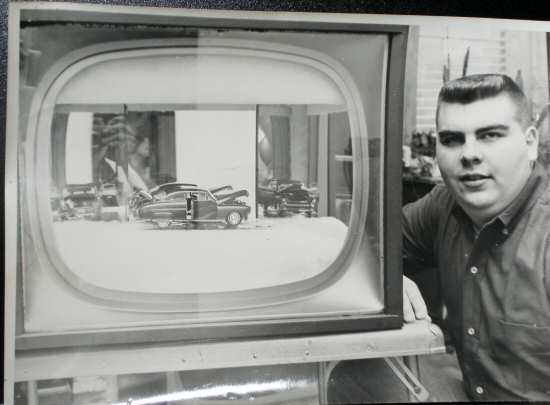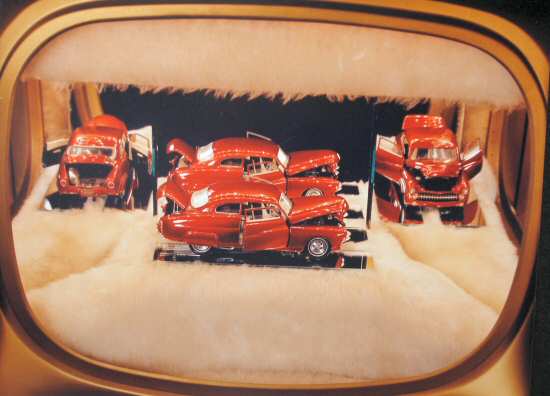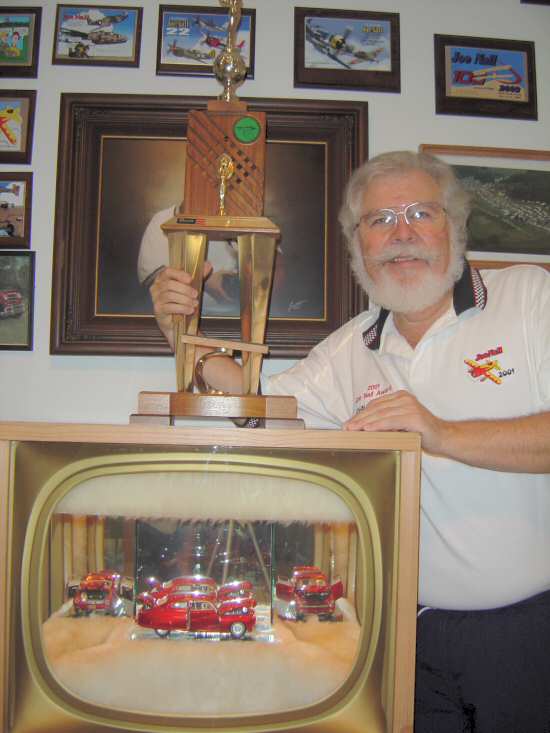The Mercury in the TV!

John was an incredibly talented builder for many decades, and laid claim to the most historic, sophisticated model in 1964 when he entered a national contest with a full custom 1949 Mercury ensconced in a hollow-out vintage television case. Check out this great article!
Special Note: The Museum has been fortunate to make the acquaintance of famed modeler John Estlow. Mark S. Gustavson has spoken with John and discovered that his famed, high-tech chopped ’49 Mercury from 1964 still exists and is in excellent condition. John’s model has helped us better understand a relatively obscure but important bit of history in which a so-called “national” contest series – ostensibly in contemporaneous competition with the famous and much-better known Revell-Pactra contests – was being presented at selected ICAS full-size car shows.
During the few years when fabled Revell-Pactra I and II national model car championships (as distinct from the later Revell-Testor I and II competitions) were in full swing, another contest series was also underway. Held in the last half of 1963 and through much of 1964, the International Modelers Guild Modelrama Championship was apparently a series of events held in conjunction with ISCA car shows.
Starting sometime in 1963, a loosely-knit (probably impromptu) organization called the International Modelers Guild held a series of model car contests across the United States, culminating in Cobo Hall in Detroit. Held under the auspices of the show car division of Promotions, Inc., according to the article in the August 1964 issue of Car Model (“Flash! World Champion Crown Awarded to Michigan Modeler,” pgs 56-57), event coverage (accorded an unusually short article allocated to a world championship) revealed that the top thirteen winners were culled from regional competitions across the United States. A further clue to this event can be seen in the background to the photo of Robert Manmiller, in that same issue of Car Model magazine, where an I.C.A.S. banner appears; additional information can be found in the March 1964 issue of Rod & Custom which features pictures from this event in the “Reader’s Models” column (p. 39).
An interesting perspective can be found in Showtime, The Story of the International Championship Auto Shows and the Hot Rod/Custom Car World, Chapter IV “Coming Together,” page 26 (Published by Promotional Displays, Inc./Publishing Division) where the author discloses:
“During the Summer of 1963, Ron Ekholm announced the formation of the International Championship Guild to oversee the International Championship Modelrama to be held in twenty major cities in the United States and Canada. With Revell as co-sponsor, a championship would be selected in each city and the city champs would then meet in a final to select the International Champion Model Craftsman. Membership was free to newsletter readers who would also receive a free subscription to Model Craft magazine (official IMG publication), a membership card, jacket patch, and free entry to the contest. Trophies and prizes would be awarded in each city with the major prize being one that all modelers would strive for. First prize in the World Modelrama, paid for by Revell, would be a life-size replica of the winning entry to be built by Ed Roth. Other prizes included all expense paid trips to Washington, D.C., Los Angeles, California, Indianapolis, Indiana to see the Indy 500 and Daytona Beach, Florida to see the Daytona 500. This array of awards and the scope of the project plus the commitment of Revell, Inc., and Promotions, Inc., would insure the success of the nation’s first national model car contest .” (Emphasis added).
This historical revelation is very interesting. At this time, as the Revell-name national contest event was being re-tooled to substitute Testor for Pactra as a co-sponsor, it is clear that Revell was also deeply involved with Bob Larivee: Showtime later reveals, on page 34, that Revell’s Lou Glaser provided financial assistance to Bob Larivee when a summer 1964 proposed deal to have Peterson Publishing purchase Promotions, Inc. fell through. For that, and other, reasons, it is not a surprise Revell would forge a relationship with Larivee to promote model car building in general and Revell’s products in particular: the record makes it plain that the International Championship Guild was the precursor to the Revell-Testor International Model Car Customizing Championship (I.S.C.A. shows held from October 1964 through April 1965) that would later be presented at ISCA shows. It is also interesting to note that the author overstated the claim that the Guild would present the nation’s ‘first national model car contest.” By most accounts, the Revell-Pactra I contest was much larger by a quantum measurement, and conducted earlier.
There is another article on ICMC contest models that appeared in “Modeling Motorcade,” Model Car Science, August 1964, pgs. 12-18. The source of the pictures taken for this article are unclear, though the article suggests that the featured models were all winners in contests apparently held in Texas, Maryland, Virginia and Washington, D.C. The models that appeared in this article do not appear to be any of the models that appeared in Revell-Pactra I and II; moreover, the small text accompanying the article suggests that these models appeared in major contests and not in local hobby store competitions. Most importantly, however, is the introductory note that specifies that the photos came from George Barris. This suggests that the contests to which reference is made in this article came from the Mid-American Model Car Championship though certainty at this point in time is impossible. As plausibly, the models featured in the Model Car Science article might have been taken during the International Modelers Guild Modelrama Championship since the work of John Estlow appears in this article and in the feature article on the contest. To add further strength to this proposition, the custom model of Charles Jones of Ypsilanti, Michigan won the top award at the same contest. The reader is invited to decide in which of these two contest series these models appeared. For further information on the saga of Chuck’s great model, go to a back issue of The Builder and read: “The Early Years of Model Car Contests in American: The Chuck Jones Saga.” www.themodelcarmuseum.org/docs/Builder-10-1-low.pdf
In any event, it appears that Charles and John won the top awards in this series but at different times. John Estlow’s warm and graciously response to the Museum’s inquiries about his model has provided a lot of information on his wild, forward-thinking full custom 1949 Mercury that won the International Modelers Guild Modelrama Championship in 1964. John was a great pioneer of early model technology, and his Mercury was a tour-de-force. In addition to the custom work (chopped top, quad headlights, opening doors, custom rear quarter panels and other changes), the breathtaking quality of this model are the incredible operational details that John installed in this model that still exists in great condition today. Check out the brief feature on this model in the August 1964 issue of Model Car Science, as well as the accompanying photos and list below that John provided:
Exterior Features:
- Quad headlights with bubble lenses
- Rolled pans, front and rear
- Corvette grille
- Dechromed body
- Tunneled antenna
- Frenched taillights with Caddy bullet lenses
- One piece front and rear windows
- Doors opened
- Candy apple red over gold base
Trunk:
- Color television set
- Complete set of tools and custom tire cover
- Interior gas filler
Interior Features:
- Opened glove box
- Console with gearshift, tach and television
- Swivel bucket seats
- Retractable seat belts
- Bullet-shaped domelight
- Ford XL style door safety lights
- Custom headrests
Engine Compartment:
- Chrysler Hemi
- Six-log intake
- Chrome horns
- Mirror under hood
Chassis:
- All running gear “chrome”plated
- Quick change rear
- Lowered front end
- Chrome mag wheels with knockoffs
- Hand-formed/chromed exhaust pipes
Operating Features (23 light bulbs):
- Trunk lights, trunk TV
- Courtesy and door lights
- TV (with sound)
- Back up and brake lights
- Front and rear single lights (from steering column)
- Tachometer
- Headlights: high and low beam
- Horn
- Engine fan spins (Atlas HO motor)
- Smoking Exhaust


